1. Development of main heat sources in residential buildings in the 2010s
The statistics on energy consumption in households monitors the development of heating modes and heat sources in residential buildings with the help of both register data and sample surveys. Already at the beginning of the 2010s, the number of oil-heated dwellings in the register was bigger than the number observed in the survey. Correspondingly, the share of district heat and ground heat in heating of residential buildings was higher in the sample survey than in the register. The change of heat sources has continued throughout the 2010s. There has been a shift from oil to district heat especially in blocks of flats and terraced houses and from oil to ground heat in one-dwelling and two-dwelling houses. The importance of heat pumps in heating has grown. According to the sample surveys, the change has been clearly faster than could be concluded from the building register.
Development of main heat sources
Publishing of the statistics on energy consumption in households started in 2011. When creating the statistics at the turn of the decade, it was observed that fitting the data on heating modes and heat sources of the building stock with data on energy sales requires a revision of the data on heat sources. Therefore, Statistics Finland began monitoring heat sources for heating with sample surveys.
In addition to data on the whole building stock in Finland, the building register includes data on heating modes and main heat sources. Register data are collected in the construction stage and in connection with renovations that require a building permit. A change of heat source requires at most a planning permission for minor construction, which is why the changes of heat source are not recorded in to the register.
The annual monitoring of heat sources in residential buildings with sample surveys was introduced in 2010 as part of the survey on income and living conditions. In 2015, the question was moved to the survey on renovation building of dwellings and detached houses. In addition to the annual sample surveys mentioned above, questions on heating mode and heat source have also been included in the Household Budget Survey and the survey on the use of heating energy in small-scale housing.
All households are included in the population of the survey on income and living conditions and the Household Budget Survey, so the surveys cover all modes of living. Renovation building of housing and detached houses concerns owner-occupied housing. Due to the uncertainty caused by the assumptions required to harmonise the data contents, the results are ballpark estimates and presented as graphs.
The largest differences in the heat sources between sample surveys and the building register are compared in figure 1 for blocks of flats, in figure 2 for terraced houses and in figure 3 for detached houses (one-dwelling and two-dwelling houses). Data on free-time residences included in the statistics on energy consumption in households are available only from individual sample surveys, such as the survey on the use of heating energy in small-scale housing in spring 2017.
Figure 1 presents the development of heat sources in dwellings in blocks of flats according to the register and the sample surveys. The majority of blocks of flats are heated with district or local heat. According to the sample surveys, the share of district and local heat is around 7 per cent higher than in the register data. The share of oil has contracted strongly. According to the sample data, the share of oil is only a few per cent. In the 2010s, ground heat has become more common also in blocks of flats.
Figure 2 describes terraced houses. At the start of the decade, the most important sources of heat in terraced houses were district heat, electricity and oil, in order of volume. Today, the order is district heat, electricity and ground heat.
Figure 3 shows the development in one-dwelling and two-dwelling houses. Electricity is the most important main source of heat in one-dwelling and two-dwelling houses. No great changes in its share is noticeable in either data source. However, the sample surveys show that the number of air heat pumps used as an additional heat source has increased steadily in electrically heated one-dwelling and two-dwelling houses (figure 4). As in blocks of flats and terraced houses, the biggest changes have occurred in the use of oil, district heat and ground heat. Ground heat is clearly more important in one-dwelling and two-dwelling houses than in blocks of flats and terraced houses.
Figure 1. The heating sources in blocks of flats in the 2010s - the largest differences between register data and sample surveys
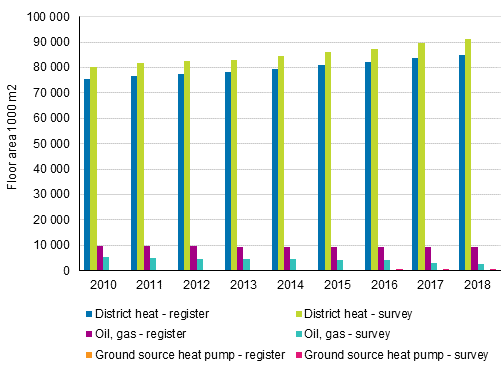
Figure 2. The heating sources in terraced houses in the 2010s - the largest differences between register data and sample surveys
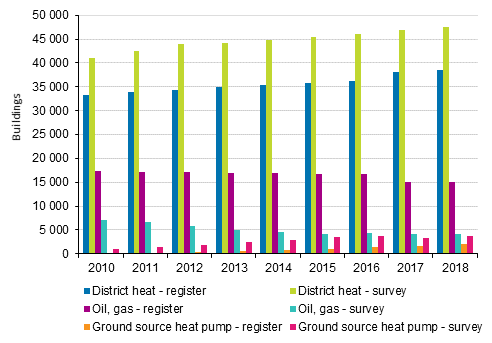
Figure 3. The heating sources in one-dwelling and two-dwelling houses in the 2010s - the largest differences between register data and sample surveys
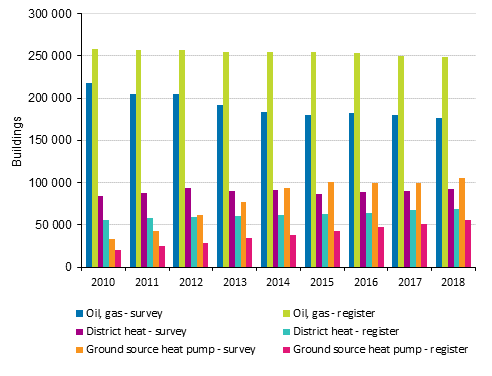
Figure 4. Development of number of air heat pumps by main heat source in one-dwelling and two-dwelling houses according to sample surveys
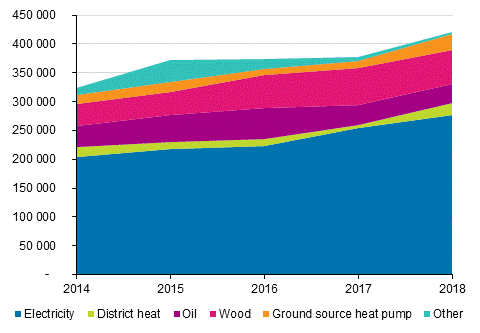
Unit-specific comparison of heat sources in detached and semi-detached houses
In the survey on the use of heating energy in small-scale housing, the response was compared with register data by dwelling. The results are presented in figure 5. The response is marked in uniform colour and the register data in halftone. According to respondents, oil heating is clearly less used and ground heat, in turn, more commonly used than the register data indicate. The differences recur in all building types. When it comes to electricity, wood and district heat, the differences between register data and data given by respondents are clearly smaller. The unit-level comparison is in line with the data from the sample surveys presented above.
The survey on the use of heating energy in small-scale housing also included free-time residences. The importance of electricity as the main heat source has increased in them, whereas that of wood has decreased.
Figure 5. Main heat source for heating according to survey responses and register by type of detached and semi-detached house – unit-level comparison
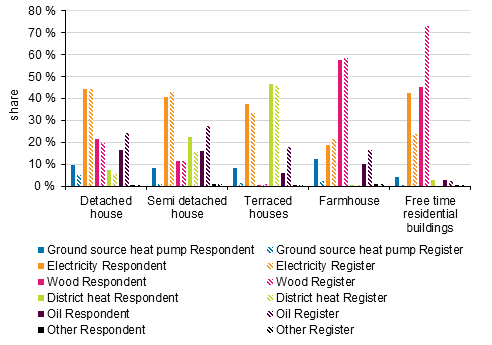
Heat pumps for heating
Figure 6 presents the development of the number of heat pumps estimated from sales data collected by the Finnish Heat Pump Association (Energy 2018 table service, table 2.11.). From the beginning of the millennium, the number of ground source heat pumps has grown nine-fold and the number of air heat pumps has grown at least 150-fold. A presumed life time of 10 years is used in the evaluation. With a life time of 15 years, the number of air heat pumps would be more than 200-fold.
The total number of heat pumps can be estimated from sales statistics, but they do not reveal the division of heat pumps between different sectors. The development of the number of heat pumps in housing has, therefore, been monitored also with the above-mentioned sample surveys. The number of ground source heat pumps according to sales statistics is in line with the results from the sample surveys. The same also applies to air-to-water and exhaust air heat pumps.
Figure 6. Development of the number of heat pumps in the 2000s estimated from sales volumes
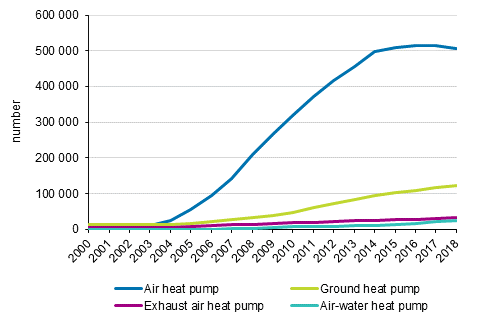
Heat pumps of detached houses, two-dwelling houses, terraced houses, blocks of flats and free-time residences are included in housing. The available surveys concern only part of housing. It is, however, possible to form a rough estimate on the number of heat pumps in housing by combining results from different sample surveys and comparing that to the development of the number calculated from sales data with different life times. Such an examination is presented in figure 7. Until 2016, the number of air heat pumps in housing calculated based on sample surveys was lower than the total number calculated with a ten-year life time. The situation changed in 2017, and now the number of air heat pumps in the housing sector exceeds the number calculated from the sales statistics based on the previous presumed life time.
Figure 7. Number of air heat pumps calculated from sales statistics with a life time of 10 and 15 years and total number calculated from sample surveys
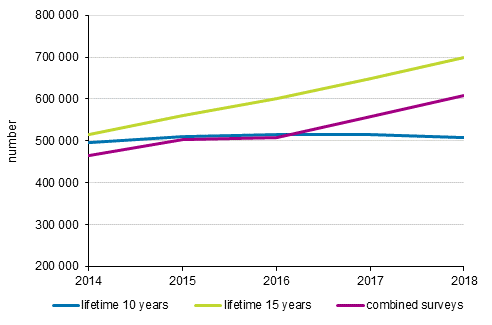
The evaluation gives cause to raise the life time of air heat pumps. Based on practical experiences, it has been suggested that the life time should be 15 years. In this case, around 15 per cent of air heat pumps would be allocated outside the housing sector. This requires that data on the use of air heat pumps needed in energy evaluation are surveyed also in other sectors than the housing sector.
Monitoring the development of heat sources
Reliable data on the use of heat sources in residential dwellings is needed for statistics on energy use in households. Sample surveys are needed to correct data on heat sources in the building register and to estimate the importance of additional heat sources such as air heat pumps. Due to the energy transition, the simultaneous use of several heat sources becomes more common. It is necessary to monitor the change with sample surveys, but the use of other data sources should also be examined.
Source: Energy consumption in households 2018, Statistics Finland
Inquiries: Virve Rouhiainen 029 551 3395, energia@stat.fi
Director in charge: Jan Nokkala
Updated 21.11.2019
Official Statistics of Finland (OSF):
Energy consumption in households [e-publication].
ISSN=2323-329X. 2018,
1. Development of main heat sources in residential buildings in the 2010s
. Helsinki: Statistics Finland [referred: 21.12.2025].
Access method: http://stat.fi/til/asen/2018/asen_2018_2019-11-21_kat_001_en.html

